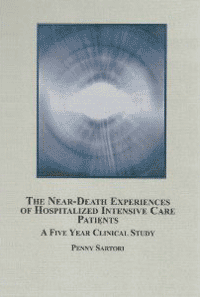 The Near Death Experiences of Hospitalized Intensive Care Patients : A Five Year Clinical Study
The Near Death Experiences of Hospitalized Intensive Care Patients : A Five Year Clinical Study
By Penny Sartori
Published by The Edwin Mellen Press, 2008.
This book is the result of a long term study into the reported incidence and phenomenology of Near Death Experiences (NDE) in a Welsh Intensive Therapy Unit (ITU). At the time of commencement of this study, most NDE research was retrospective (Moody 1975, Ring 1980, Sabon 1982). A similar study, by Dr. Sam Parnia was begun at the same time, and followed a similar protocol, both projects being supervised by Dr. Peter Fenwick. Further prospective studies have since been published (Parnia 2005, Schwaninger 2002).
The aim of this study was to establish if reductionist arguments for NDE’s, including anotia, hypercarbia or drug administration could explain what patients had described. One aspect of the study was attempted to verify the out of body component of the NDE by placing brightly coloured symbols in positions within the ITU which could only be viewed from an out of the body perspective. Similar quantitative studies are currently underway (Parnia 2008)
This study by Sartori was undertaken during the summer of 1997. The official data collection began in January 1998 and was completed in January 2003. The methodology involved data collection, interviews, transcribing and data analysis. All of these were undertaken by the author for her PhD thesis. Each patient interviewed was simply asked “Do you have any recollections of anything during the time that you were unconscious?” . The results were interesting, not least in the serious doubts they raise about the reductionist theories for NDE’s suggested by some researchers (Blackmore 1993).
What makes this study even more interesting and useful, is that Sartori takes the time to place the NDE into its rightful historical context by examining the historical and cultural elements of the NDE. It may surprise many to learn that a commonly thought of ‘core experience’ of the NDE, the ‘tunnel of light’, is not present in some none western cultures and European historical accounts. For those who believe that the NDE is drug induced or the result of the ‘dying brain’ hypothesis this is a severe blow. That the NDE raises serious ontological questions about the nature of consciousness is beyond doubt to all but the most closed minded. Sartori raises many epistemological questions during her research, and it is only with more studies of this caliber that we have any chance of getting to grips with one of the most puzzling and important questions facing us at the moment.
References:
Blackmore, S. (1993) Dying to Live. Prometheus Books
Moody, R. (1975) Life After Life. Bantam Books
Parnia, S. (2005) What Happens When We Die. Hay House
Parnia, S. (2008) Personal communication
Ring, K. (1980) Life at Death. Coward, McCann & Geoghegan
Sabon, M. (1982) Recollections of Death: An Investigation Revealing Striking New Medical Evidence of Life After Death. Corgi Books
Schwaninger, J. (2002) A Prospective Analysis of Near-Death Experiences in Cardiac Arrest Patients. Journal of Near-Death Studies, Summer, 20(4), pp. 215-32
Review by David Taylor


